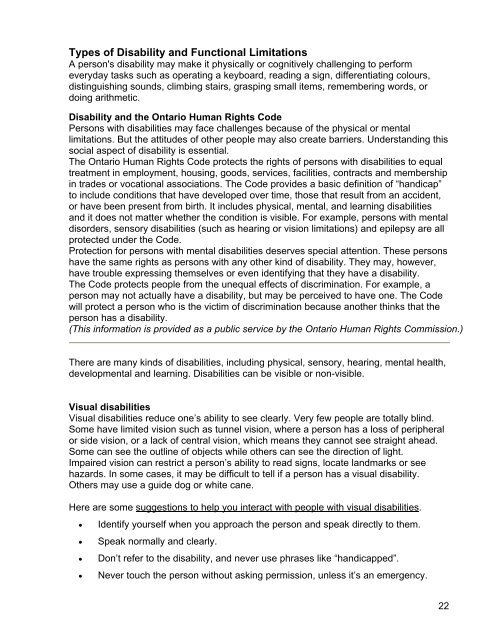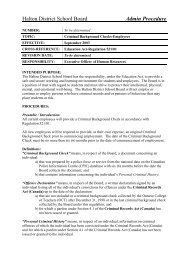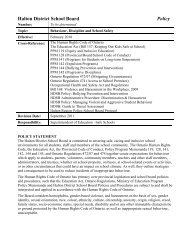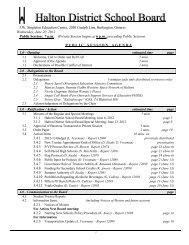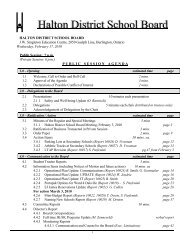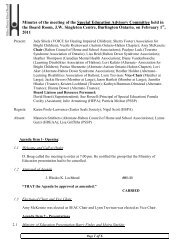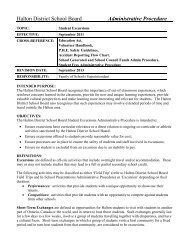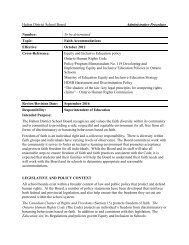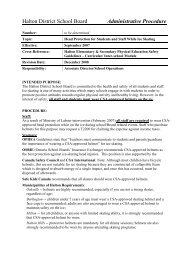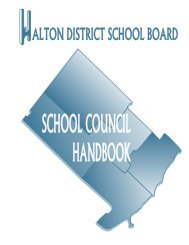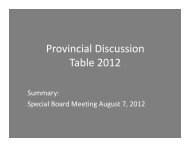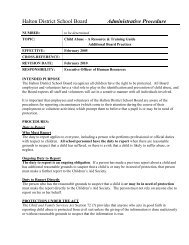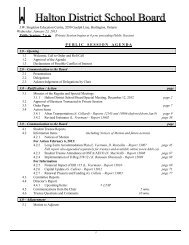2006-2007 Accessibility Plan - Halton District School Board
2006-2007 Accessibility Plan - Halton District School Board
2006-2007 Accessibility Plan - Halton District School Board
You also want an ePaper? Increase the reach of your titles
YUMPU automatically turns print PDFs into web optimized ePapers that Google loves.
Types of Disability and Functional Limitations<br />
A person's disability may make it physically or cognitively challenging to perform<br />
everyday tasks such as operating a keyboard, reading a sign, differentiating colours,<br />
distinguishing sounds, climbing stairs, grasping small items, remembering words, or<br />
doing arithmetic.<br />
Disability and the Ontario Human Rights Code<br />
Persons with disabilities may face challenges because of the physical or mental<br />
limitations. But the attitudes of other people may also create barriers. Understanding this<br />
social aspect of disability is essential.<br />
The Ontario Human Rights Code protects the rights of persons with disabilities to equal<br />
treatment in employment, housing, goods, services, facilities, contracts and membership<br />
in trades or vocational associations. The Code provides a basic definition of “handicap”<br />
to include conditions that have developed over time, those that result from an accident,<br />
or have been present from birth. It includes physical, mental, and learning disabilities<br />
and it does not matter whether the condition is visible. For example, persons with mental<br />
disorders, sensory disabilities (such as hearing or vision limitations) and epilepsy are all<br />
protected under the Code.<br />
Protection for persons with mental disabilities deserves special attention. These persons<br />
have the same rights as persons with any other kind of disability. They may, however,<br />
have trouble expressing themselves or even identifying that they have a disability.<br />
The Code protects people from the unequal effects of discrimination. For example, a<br />
person may not actually have a disability, but may be perceived to have one. The Code<br />
will protect a person who is the victim of discrimination because another thinks that the<br />
person has a disability.<br />
(This information is provided as a public service by the Ontario Human Rights Commission.)<br />
There are many kinds of disabilities, including physical, sensory, hearing, mental health,<br />
developmental and learning. Disabilities can be visible or non-visible.<br />
Visual disabilities<br />
Visual disabilities reduce one’s ability to see clearly. Very few people are totally blind.<br />
Some have limited vision such as tunnel vision, where a person has a loss of peripheral<br />
or side vision, or a lack of central vision, which means they cannot see straight ahead.<br />
Some can see the outline of objects while others can see the direction of light.<br />
Impaired vision can restrict a person’s ability to read signs, locate landmarks or see<br />
hazards. In some cases, it may be difficult to tell if a person has a visual disability.<br />
Others may use a guide dog or white cane.<br />
Here are some suggestions to help you interact with people with visual disabilities.<br />
• Identify yourself when you approach the person and speak directly to them.<br />
• Speak normally and clearly.<br />
• Don’t refer to the disability, and never use phrases like “handicapped”.<br />
• Never touch the person without asking permission, unless it’s an emergency.<br />
22


